|
Senenmut |
last update: 01.01.2010 | |
|
TT71 - Rock-cut Stelae |
| From the original colored decoration of walls and ceilings today only very small parts have survived, so among other 9 wall parts formed like small stelae which are filled with inscriptions. These show clear signs of destruction. |
| These 9 rock-cut stelae belong to the most unusual decorative feature of tomb TT71. They are carved at uneven intervals and at different heights into the two walls of the axial corridor - the numbers 1 - 6 are located on the southern, 7 - 9 on the northern wall. |
| The surface of the stelae were cut about 8 - 9 cm deep into the surface of the wall and painted white. The hieroglyphics itself were cut into these surface in raised relief without any further interior modeling. Originally all were painted blue. The stelae differ in size and shape, however they all have a rounded top. Everyone contains a title of Senenmut, some contain the names of his parents as well. |
| The rock-cut stelae may have been integrated into the surrounding decoration of the walls but today the remains hardly give a hint how that was achieved. But due to their form, the surface area painted in white color, and the execution of the inscriptions it is evident that they should imitate free standing stelae. |
| Above a schematic reconstruction of the southern wall (left wall) of the axial corridor (after Dorman, 1991); the reconstruction shows in the lower series from left to right the arrangement of the of stelae 1 - 6. Clicking on a stela jumps to the corresponding figure below. |
| In the upper left corner the wall shows the ritual pilgrimage to Abydos (on the left a sailing boat is visible and - on the right of it - a smaller boat connected to the sailing boat by a rope, the small boat carries a sarcophagus); in same height - but on the right as part of a Banquet scene Senimen is depicted and behind him his wife or mother, Seniemyah. |
| Above the reconstruction of the northern wall (right wall) of the axial corridor (after Dorman, 1991) which in the lower series - this time from right to left - shows the arrangement of stelae 7 - 9. Clicking on a stela jumps to the corresponding figure below. |
| On the left part Senenmut is shown watching two smaller writers. In the middle part several men are shown, who are pulling shrines mounted on sledges - obviously this shows a part of the funeral equipment carried to the tomb. |
| In the following one all 9 rock-cut stelae are shown individually and described on the information presented by Dorman (1991). The destroyed texts are put in [square brackets ] in each case. The dim daylight deep in the corridor is responsible for the dark pictures. |
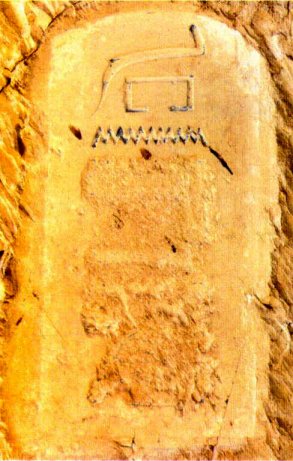 |
the rock-cut Stela No. 1 (after Dorman
1991) on the southern wall of the corridor;
(H: 73 cm, W:36 cm); the single column of text facing right (west) can be translated as: "The steward of [Amun, Senenmut]." One clearly detects 2 differently destroyed surfaces - the signs in the upper were chiseled away with a finer tool than the lower. The upper part contained "Amun", the lower the name "Senenmut". Due to the different handling it is assumed that the name Senenmut was destroyed directly after his fall, the name of Amun during the Amarna period.
|
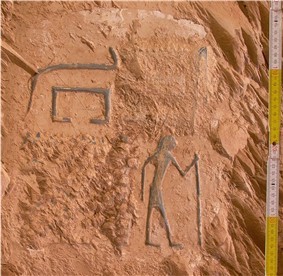 |
Stela No. 2 on the
southern wall of the corridor;
(H: 37 cm, W:29 cm); "The great steward [of Amun, Senenmut]." Curiously, the text is to be read in a double diagonal, beginning in the upper left corner, than moving to the lower right corner, than from the upper right corner [-> Amun] to the lower left corner [-> Senenmut]. The reason for this composition, which is unique in the tomb, is not known. |
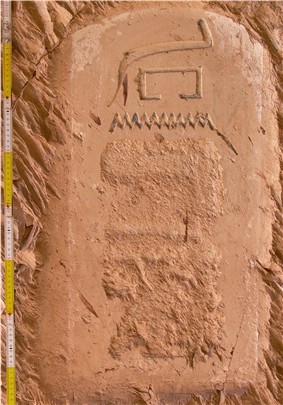 |
Stela No. 3 on the
southern wall of the corridor;
(H: 52 cm, W:26 cm);
single column of text facing right (west), text and arrangement are identical to Stela No.1
|
 |
Stela No. 4 on the southern wall of the
corridor;
(H: 71 cm, W:43 cm); two columns of text facing left (east), translated: "The overseer of the granaries of [Amun, Senenmut], engendered by Ra-mose, born by Hat-nofer."
|
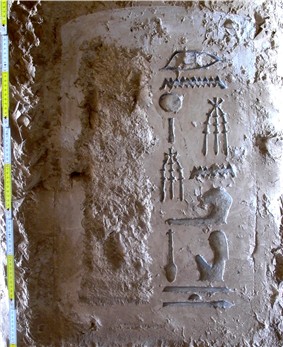 |
Stela No. 5 on the southern
wall of the corridor;
(H: 74 cm, W:44 cm); two columns of text facing left (east), showing thoroughly mutilated names as well as titles (Amuns und Senenmut), thus, it is not sure how to read the text but most likely it should be read as "[The steward (?) of Amun, Senenmut, justified], engendered by Ra-mose, born by Hat-nofer." The title possible could have been "mj-ra Snwtj", i.e. "Chief of the granaries (barns)".
|
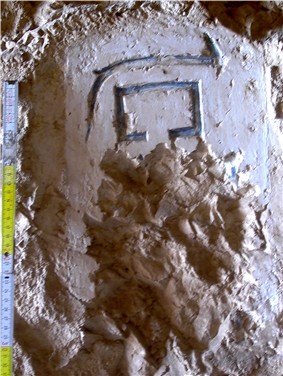 |
Stela No. 6 on the
southern wall of the corridor;
(H: 37 cm, W:23 cm); a single column of text facing right (west) "The steward, Senenmut."
|
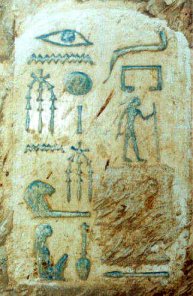 |
Stela No. 7 on the northern
wall of the corridor;
(H: 36 cm, W:22 cm); two columns of text facing right (east) and translated by Dorman as follows: 1. right column - The great steward [Senenmut, justi]fied
As in other stela the name of Senenmut is cut away (printed in italics). Some signs in the left column still show traces of the blueprint - here done in red lines (e.g. in front of the lion's chest). To show the red lines the photo was slightly lightened using a photo editor.
|
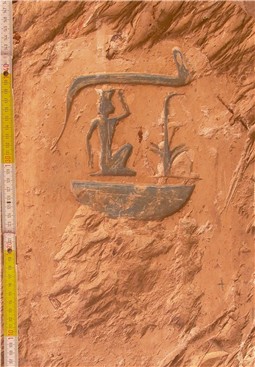 |
Stela No. 8 on the northern
wall of the corridor;
(H: 67 cm, W:42 cm); one single column of text facing right (east) and translated as: - The overseer of all royal works, [Senenmut].
|
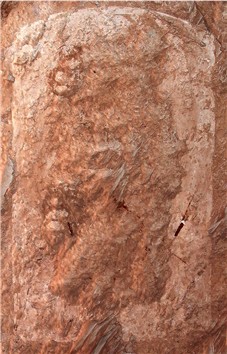 |
Stela No. 9 on the
northern wall of the corridor;
(H: 37 cm, W:24 cm); the text was thoroughly destroyed, most likely is was a single column of text facing right (east) - although every sign was erased Dorman believes that the text has to be read as: "The steward, Senenmut."
|
| With regard to the reading of the inscriptions by Dorman (1991) it must to be mentioned that the destroyed surfaces still show tracks of the original hieroglyphic signs. These traces do not show up very clearly here in the photos. On the basis these tracks, which Dorman (1991) has marked in his publication about the tombs of Senenmut, the destroyed signs; can be - with a certain intuition - completed in most of the rock-cut stelae. |

